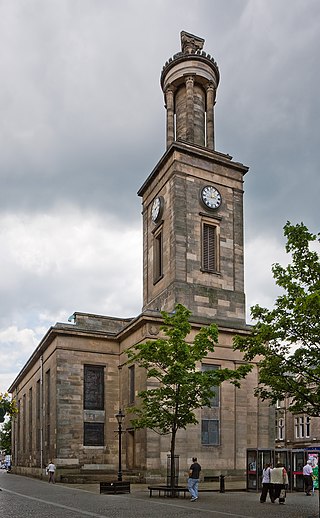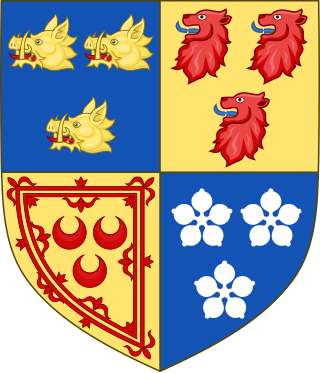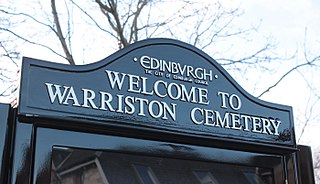Related Research Articles

The Dean Cemetery is a historically important Victorian cemetery north of the Dean Village, west of Edinburgh city centre, in Scotland. It lies between Queensferry Road and the Water of Leith, bounded on its east side by Dean Path and on its west by the Dean Gallery. A 20th-century extension lies detached from the main cemetery to the north of Ravelston Terrace. The main cemetery is accessible through the main gate on its east side, through a "grace and favour" access door from the grounds of Dean Gallery and from Ravelston Terrace. The modern extension is only accessible at the junction of Dean Path and Queensferry Road.

Sir Henry Raeburn was a Scottish portrait painter. He served as Portrait Painter to King George IV in Scotland.

Elgin is a town and formerly a Royal Burgh in Moray, on the North Coast of Scotland. It is the administrative and commercial centre for Moray. The town originated to the south of the River Lossie on the higher ground above the floodplain where the town of Birnie is. There, the church of Birnie Kirk was built in 1140 and serves the community to this day.

Clan Brodie is a Scottish clan whose origins are uncertain. The first known Brodie chiefs were the Thanes of Brodie and Dyke in Morayshire. The Brodies were present in several clan conflicts, and during the civil war were ardent covenanters. They resisted involvement in the Jacobite uprisings, and the chief's family later prospered under the British Empire in colonial India.
This is a list of people who have served as Lord Lieutenant of Moray, Scotland. Until 1928 the office was known as Lord Lieutenant of the County of Elgin.

Alexander Seton, 1st Earl of Huntly, who adopted the family name of Gordon from about 1457, was a powerful 15th-century Scottish magnate. He was knighted in 1439/1440 and was Lord of Badenoch, Gordon, Strathbogie and Cluny.

Elizabeth Hay, Countess of Erroll was an illegitimate daughter of King William IV of the United Kingdom and Dorothea Jordan. She married William Hay, 18th Earl of Erroll, and became Countess of Erroll on 4 December 1820 at age 19. Due to Hay's parentage, William Hay became Lord Steward of the Household. Elizabeth and William Hay married at St George's, Hanover Square. Hay is pictured in a FitzClarence family portrait in House of Dun, and kept a stone thrown at her father William IV and the gloves he wore on opening his first Parliament as mementos.

Greyfriars Kirkyard is the graveyard surrounding Greyfriars Kirk in Edinburgh, Scotland. It is located at the southern edge of the Old Town, adjacent to George Heriot's School. Burials have been taking place since the late 16th century, and a number of notable Edinburgh residents are interred at Greyfriars. The Kirkyard is operated by City of Edinburgh Council in liaison with a charitable trust, which is linked to but separate from the church. The Kirkyard and its monuments are protected as a category A listed building.

The Chambers Institution is a municipal structure in the High Street in Peebles, Scotland. The structure, which was designed to accommodate a library, a museum, an art gallery and Peebles Burgh Hall, is a Category A listed building.

Warriston Cemetery is a cemetery in Edinburgh. It lies in Warriston, one of the northern suburbs of Edinburgh, Scotland. It was built by the then newly-formed Edinburgh Cemetery Company, and occupies around 14 acres (5.7 ha) of land on a slightly sloping site. It contains many tens of thousands of graves, including notable Victorian and Edwardian figures, the most eminent being the physician Sir James Young Simpson.

Cullen Old Church is the parish church for Cullen and Deskford, in Moray. It was originally a part of the Roman Catholic Church, but has been a part of the Church of Scotland since the Scottish Reformation. John R. Hume describes Cullen Old Church as a fine example of late Scots Gothic architecture, and it was designated a Category A listed building in 1972. It is still an active place of worship, with weekly services presided over by Rev Douglas F Stevenson.
The Barony of Muirton is a Scottish feudal barony near Forres along the Findhorn River in Moray.
Alexander Clark of Balbirnie was a Scottish merchant and Provost of Edinburgh. He was closely involved with English diplomacy.
Archibald Stewart was a Scottish merchant and Provost of Edinburgh.
References
Mackintosh, Herbert B: Elgin Past and Present, Elgin, 1914